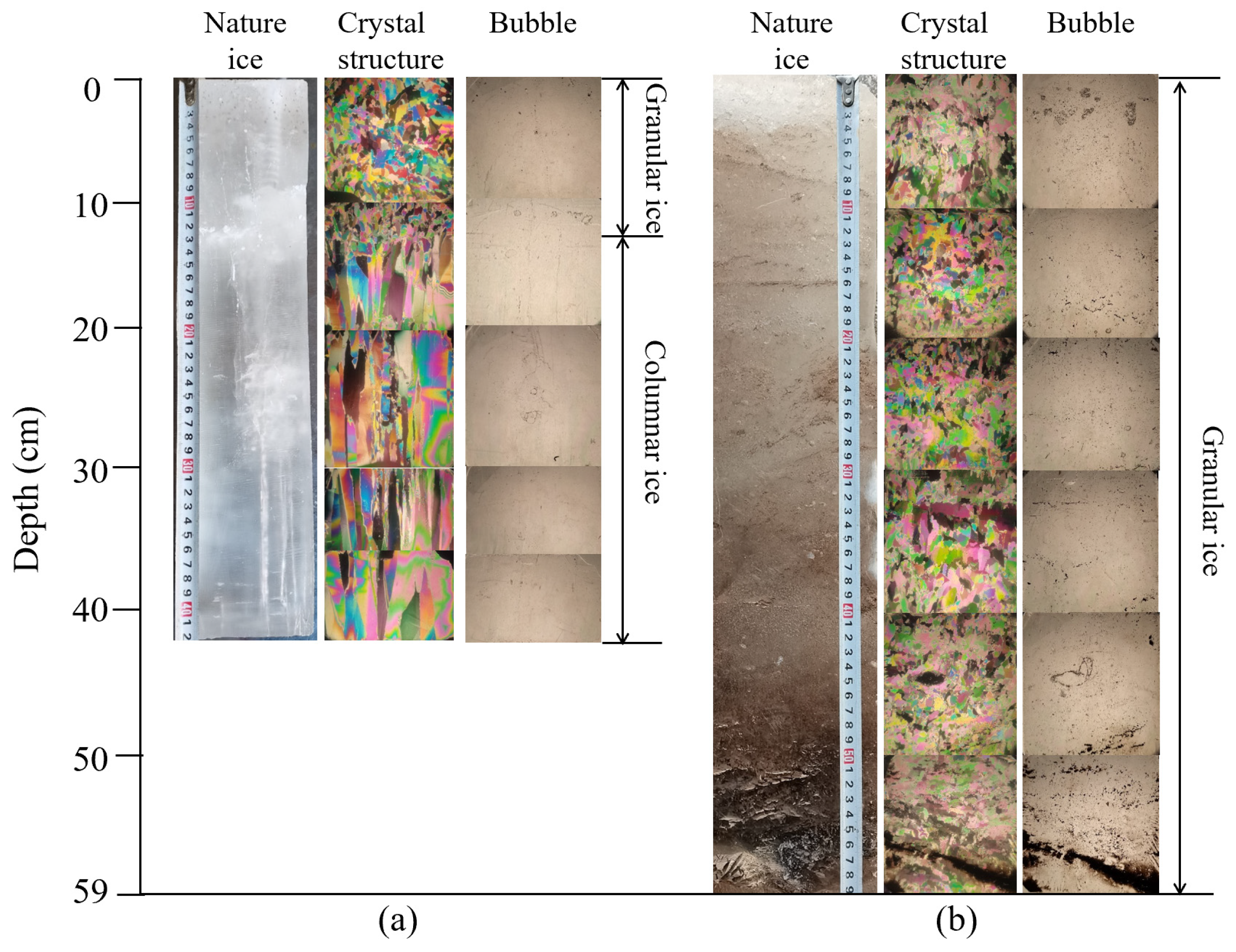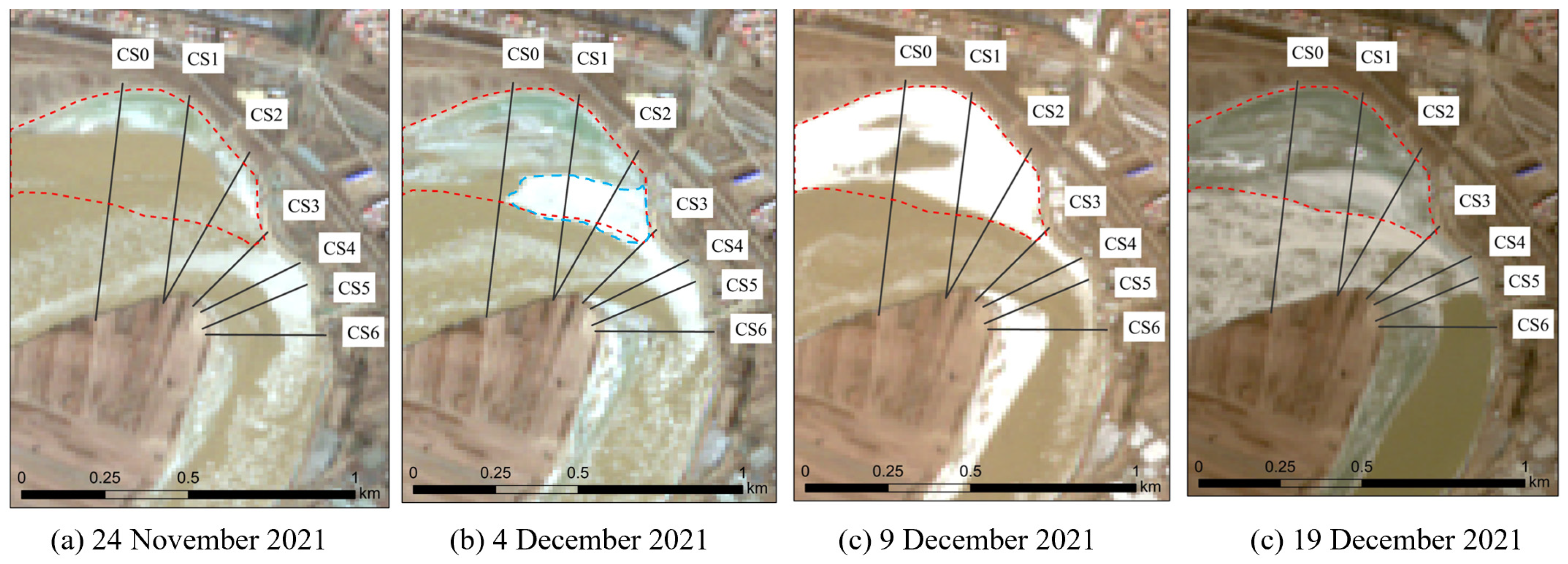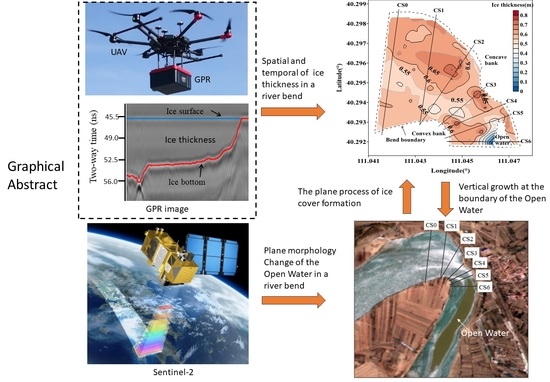Morphology Dynamics of Ice Cover in a River Bend Revealed by the UAV-GPR and Sentinel-2
Abstract
:1. Introduction
2. Materials and Methods
2.1. Study Area
2.2. Ice Thickness Measurement Using UAV-GPR
2.3. Open Water Monitoring with Sentinel-2
2.4. Measured Ice Thickness and Dielectric Permittivity
2.5. Spatial Interpolation Processing
3. Results
3.1. Spatial and Temporal Distribution of Ice thickness
3.2. Plane Morphology Change of the Open Water
3.3. Vertical Growth of Ice Thickness at the Boundary of the Open Water
4. Discussion
4.1. Detection of Hummocky Ice and Flat Ice Using UAV-GPR
4.2. Comparison of the Ice Thickness on Concave and Convex Banks
5. Conclusions
- (1)
- The average dielectric permittivity were 3.231, 3.249, and 3.317 on 5 January 2022, 16 February 2022, and 25 February 2022, respectively, which are larger than the pure ice dielectric permittivity of 3.17. The average ice thicknesses were 0.402 m ± 0.044 m, 0.509 m ± 0.066 m, and 0.633 m ± 0.082 m on the three surveys in the Shisifenzi bend, respectively.
- (2)
- The ice thickness distribution in the bend was uneven. The ice thickness was thicker near the concave bank in the upstream of CS3. In addition, the ice thickness was thinner in the mainstream. The average growth rate of ice thickness in the mainstream was 0.006 m d−1, and in the non-mainstream region it was 0.008 m d−1. The former was 1.242 times more than the latter.
- (3)
- In the downstream of the Shisifenzi bend, the plane morphology changes of the open water went through two stages. Firstly, the longitudinal length of the open water rapidly shortened, driven mainly by the hydrodynamic effect bringing frazil ice and broken bank ice. Secondly, the non-mainstream ice cover near the open water grew slowly transversely under the effect of accumulated negative air temperature.
- (4)
- The vertical growth of ice thickness at the boundary of the open water was not uniform. The ice-cover boundary was of two arcs, named Arc I (close to the open-water surface) and Arc II. The slope of Arc I was steeper than that of Arc II and the hazardous distance of the open-water boundary was 10.3 m. The increased flow made the change in the slope of Arc I, which broke the original balance of the hydrodynamic erosion and the thermal growth of ice cover. Moreover, it mostly affected the ice-cover growth change in Arc I, not in Arc II.
Author Contributions
Funding
Data Availability Statement
Acknowledgments
Conflicts of Interest
References
- Shen, H.T. Mathematical modeling of river ice processes. Cold Reg. Sci. Technol. 2010, 62, 3–13. [Google Scholar] [CrossRef]
- Beltaos, S.; Bonsal, B. Climate change impacts on Peace River ice thickness and implications to ice-jam flooding of Peace-Athabasca Delta, Canada. Cold Reg. Sci. Technol. 2021, 186, 103279. [Google Scholar] [CrossRef]
- Chen, P.; Cheng, T.; Wang, J.; Cao, G. Accumulation and evolution of ice jams influenced by different ice discharge: An experimental analysis. Front. Earth Sci. 2023, 10, 1054040. [Google Scholar] [CrossRef]
- Zhao, S.; Li, C.; Li, C.; Shi, X.; Zhao, S. Processes of river ice and ice-jam formation in Shisifenzi Bend of the Yellow River. J. Hydraul. Eng. 2017, 48, 351–358. (In Chinese) [Google Scholar] [CrossRef]
- Zhai, B.; Liu, L.; Shen, H.T.; Ji, S. A numerical model for river ice dynamics based on discrete element method. J. Hydraul. Res. 2022, 60, 543–556. [Google Scholar] [CrossRef]
- Smith, D.G.; Pearce, C.M. Ice jam-caused fluvial gullies and scour holes on northern river flood plains. Geomorphology 2002, 42, 85–95. [Google Scholar] [CrossRef]
- Ferrick, M.G.; Mulherin, N. Framework for control of dynamic ice break-up by river regulation. Regul. River 1989, 3, 79–92. [Google Scholar] [CrossRef] [Green Version]
- Mahabir, C.; Hicks, F.; Fayek, A.R. Neuro-fuzzy River ice breakup forecasting system. Cold Reg. Sci. Technol. 2006, 46, 100–112. [Google Scholar] [CrossRef]
- Das, A.; Budhathoki, S.; Lindenschmidt, K. A stochastic modelling approach to forecast real-time ice jam flood severity along the transborder (New Brunswick/Maine) Saint John River of North America. Stoch. Environ. Res. Risk Assess. 2022, 36, 1903–1915. [Google Scholar] [CrossRef]
- Lei, R.; Li, Z.; Qin, J.; Cheng, Y. Investigation of new technologies for in-situ ice thickness observation. Adv. Water Sci. 2009, 20, 287–292. [Google Scholar] [CrossRef]
- Marko, J.R.; Jasek, M. Sonar detection and measurements of ice in a freezing river I: Methods and data characteristics. Cold Reg. Sci. Technol. 2010, 63, 121–134. [Google Scholar] [CrossRef]
- Xie, F.; Lu, P.; Li, Z.; Wang, Q.; Zhang, H.; Zhang, Y. A floating remote observation system (FROS) for full seasonal lake ice evolution studies. Cold Reg. Sci. Technol. 2022, 199, 103557. [Google Scholar] [CrossRef]
- Li, Z.; Li, C.; Yang, Y.; Zhang, B.; Deng, Y.; Li, G. Physical Mechanism and Parameterization for Correcting Radar Wave Velocity in Yellow River Ice with Air Temperature and Ice Thickness. Remote Sens. 2023, 15, 1121. [Google Scholar] [CrossRef]
- Worby, A.P.; Griffin, P.W.; Lytle, V.I.; Massom, R. On the use of electromagnetic induction sounding to determine winter and spring sea ice thickness in the Antarctic. Cold Reg. Sci. Technol. 1999, 29, 49–58. [Google Scholar] [CrossRef]
- Morozov, P.A.; Berkut, A.I.; Vorovsky, P.L.; Morozov, F.P.; Pisarev, S.V. Measuring Sea ice thickness with the LOZA geo radar. Russ. J. Earth Sci. 2021, 21, 3. [Google Scholar] [CrossRef]
- Li, X.; Feng, X.; Liang, W.; Xue, C.; Zhou, H.; Wang, Y. A full-polarimetric GPR system and its application in ice crack detection. IOP Conf. Ser. Earth Environ. Sci. 2021, 660, 012026. [Google Scholar] [CrossRef]
- Liu, J.; Wang, S.; He, Y.; Li, Y.; Wang, Y.; Wei, Y.; Che, Y. Estimation of Ice Thickness and the Features of Subglacial Media Detected by Ground Penetrating Radar at the Baishui River Glacier No. 1 in Mt. Yulong, China. Remote Sens. 2020, 12, 4105. [Google Scholar] [CrossRef]
- Karušs, J.; Lamsters, K.; Ješkins, J.; Sobota, I.; Džeriņš, P. UAV and GPR Data Integration in Glacier Geometry Reconstruction: A Case Study from Irenebreen, Svalbard. Remote Sens. 2022, 14, 456. [Google Scholar] [CrossRef]
- Best, H.; McNamara, J.P.; Liberty, L. Association of ice and river channel morphology determined using ground-penetrating radar in the kuparuk river, Alaska. Arct. Antarct. Alp. Res. 2005, 37, 157–162. [Google Scholar] [CrossRef] [Green Version]
- Richards, E.; Stuefer, S.; Rangel, R.C.; Maio, C.; Belz, N.; Daanen, R. An evaluation of GPR monitoring methods on varying river ice conditions: A case study in Alaska. Cold Reg. Sci. Technol. 2023, 210, 103819. [Google Scholar] [CrossRef]
- Han, H.; Li, Y.; Li, W.; Liu, X.; Wang, E.; Jiang, H. The influence of the internal properties of River Ice on Ground Penetrating Radar Propagation. Water 2023, 15, 889. [Google Scholar] [CrossRef]
- Kovachis, N.; Maxwell, J.; Hicks, F. Suitability of aerial GPR deployments for river ice thickness mapping. In Proceedings of the 15th CRIPE Workshop on River Ice, St. John’s, NL, Canada, 15–17 June 2009. [Google Scholar]
- Kemp, J.E.; Davies, E.G.R.; Loewen, M.R. Spatial variability of ice thickness on stormwater retention ponds. Cold Reg. Sci. Technol. 2019, 159, 106–122. [Google Scholar] [CrossRef]
- Arcone, S.A.; Delaney, A.J. Airborne river-ice thickness profiling with helicopter-borne UHF short-pulse radar. J. Glaciol. 1987, 33, 330–340. [Google Scholar] [CrossRef] [Green Version]
- Arcone, S.A. Dielectric permittivity and layer-thickness interpretation of helicopter-borne short-pulse radar waveforms reflected from wet and dry river-ice sheets. IEEE Geosci. Remote 1991, 29, 768–777. [Google Scholar] [CrossRef]
- Delaney, A.J.; Arcone, S.A.; Chacho, E.F. Winter Short-Pulse Radar Studies on the Tanana River, Alaska. Arctic 1990, 43, 244–250. [Google Scholar] [CrossRef] [Green Version]
- Li, Z.; Jia, Q.; Zhang, B.; Leppäranta, M.; Lu, P.; Huang, W. Influences of gas bubble and ice density on ice thickness measurement by GPR. Appl. Geophys. 2010, 7, 105–113. [Google Scholar] [CrossRef]
- Liu, H.; Takahashi, K.; Sato, M. Measurement of dielectric permittivity and thickness of snow and ice on a Brackish Lagoon using GPR. IEEE J.-STARS. 2014, 7, 820–827. [Google Scholar] [CrossRef]
- Kämäri, M.; Alho, P.; Colpaert, A.; Lotsari, E. Spatial variation of river-ice thickness in a meandering river. Cold Reg. Sci. Technol. 2017, 137, 17–29. [Google Scholar] [CrossRef]
- Fu, H.; Liu, Z.; Guo, X.; Cui, H. Double-frequency ground penetrating radar for measurement of ice thickness and water depth in rivers and canals: Development, verification, and application. Cold Reg. Sci. Technol. 2018, 154, 85–94. [Google Scholar] [CrossRef]
- Fu, H.; Guo, X.; Wang, T.; Xin, G.; Li, J.; Pan, J. Dielectric constant of ice in Natural Rivers. J. Hydrol. 2022, 615, 128700. [Google Scholar] [CrossRef]
- Bai, X.; Wang, L.; Luo, X.; Mi, H.; Chen, H.; Liu, L.; Ji, M.; Gao, Y. A layer tracking method for ice thickness detection based on GPR mounted on the UAV. In Proceedings of the 4th International Conference on Imaging, Signal Processing and Communications (ICISPC), Kumamoto, Japan, 23–25 October 2020. [Google Scholar] [CrossRef]
- Deng, Y.; Li, C.; Li, Z.; Zhang, B. Dynamic and full-time acquisition technology and method of ice data of Yellow River. Sensors 2021, 22, 176. [Google Scholar] [CrossRef] [PubMed]
- Wei, Q.; Yao, X.; Zhang, H.; Duan, H.; Jin, H.; Chen, J.; Cao, J. Analysis of the variability and influencing factors of ice thickness during the ablation period in Qinghai Lake using the GPR ice monitoring system. Remote Sens. 2022, 14, 2437. [Google Scholar] [CrossRef]
- Cooley, S.W.; Pavelsky, T.M. Spatial and temporal patterns in Arctic River ice breakup revealed by automated ice detection from MODIS imagery. Remote Sens. Environ. 2016, 175, 310–322. [Google Scholar] [CrossRef]
- Zhang, X.; Jin, J.; Lan, Z.; Li, C.; Fan, M.; Wang, Y.; Yu, X.; Zhang, Y. ICENET: A Semantic Segmentation Deep Network for River Ice by Fusing Positional and Channel-Wise Attentive Features. Remote Sens. 2020, 12, 221. [Google Scholar] [CrossRef] [Green Version]
- Zhang, X.; Yue, Y.; Han, L.; Li, F.; Yuan, X.; Fan, M.; Zhang, Y. River ice monitoring and change detection with multi-spectral and SAR images: Application over yellow river. Multimed. Tools Appl. 2021, 80, 28989–29004. [Google Scholar] [CrossRef]
- Li, H.; Li, H.; Wang, J.; Hao, X. Monitoring high-altitude river ice distribution at the basin scale in the northeastern Tibetan Plateau from a Landsat time-series spanning 1999–2018. Remote Sens. Environ. 2020, 247, 111915. [Google Scholar] [CrossRef]
- Li, H.; Li, H.; Wang, J.; Hao, X. Revealing the river ice phenology on the Tibetan Plateau using Sentinel-2 and Landsat 8 overlapping orbit imagery. J. Hydrol. 2023, 619, 129285. [Google Scholar] [CrossRef]
- Zhang, F.; Mosaffa, M.; Chu, T.; Lindenschmidt, K.-E. Using remote sensing data to parameterize ice jam modeling for a northern inland delta. Water 2017, 9, 306. [Google Scholar] [CrossRef] [Green Version]
- Palomaki, R.T.; Sproles, E.A. Quantifying the Effect of River Ice Surface Roughness on Sentinel-1 SAR Backscatter. Remote Sens. 2022, 14, 5644. [Google Scholar] [CrossRef]
- Mermoz, S.; Allain, S.; Bernier, M.; Pottier, E.; Sanden, J.V.D.; Chokmani, K. Retrieval of river ice thickness from C-band PolSAR data. In Proceedings of the 2012 IEEE International Geoscience and Remote Sensing Symposium, Munich, Germany, 22–27 July 2012. [Google Scholar] [CrossRef] [Green Version]
- Zhang, H.; Li, H.; Li, H. Monitoring the Ice Thickness in High-Order Rivers on the Tibetan Plateau with Dual-Polarized C-Band Synthetic Aperture Radar. Remote Sens. 2022, 14, 2591. [Google Scholar] [CrossRef]
- Luo, H.; Ji, H.; Gao, G.; Zhang, B.; Mou, X. Study on the characteristics of flow and ice jam in Shisifenzi bend in the Yellow River during the freeze-up period. J. Hydraul. Eng. 2020, 51, 1089–1100. (In Chinese) [Google Scholar] [CrossRef]
- Li, Z.; Sun, W.; Xu, S.; Li, Q.; Bai, Y.; Wang, X. Calculating River ice thickness from Harbin to Tongjiang using short-term hydrological and meteorological data. Adv. Water Sci. 2009, 20, 428–433. (In Chinese) [Google Scholar] [CrossRef]
- Polvi, L.E.; Dietze, M.; Lotsari, E.; Turowski, J.M.; Lind, L. Seismic monitoring of a subarctic river: Seasonal variations in hydraulics, sediment transport, and ice dynamics. J. Geophys. Res. Earth Surf. 2020, 125, e2019JF005333. [Google Scholar] [CrossRef]
- Luo, H.; Ji, H.; Gao, G.; Mou, X.; Zhang, B. Application of airborne radar in ice thickness measurement during stable freezing period of Yellow River. Adv. Sci. Technol. Water Resour. 2020, 40, 44–54. (In Chinese) [Google Scholar]
- Zhang, B.; Zhang, F.; Liu, Z.; Han, H.; Li, Z. Field experimental study of the characteristics of GPR images of Yellow River ice. South North Water Transf. Water Sci. Technol. 2017, 15, 121–125. (In Chinese) [Google Scholar] [CrossRef]
















| Time | Measured Ice Thickness (cm) | Two-Way Time (ns) | Dielectric Permittivity | Average Dielectric Permittivity for Each Survey |
|---|---|---|---|---|
| 5 January 2022 | 50.5 | 6.089 | 3.271 | 3.231 |
| 54.6 | 6.501 | 3.190 | ||
| 16 February 2022 | 57.0 | 6.387 | 2.825 | 3.249 |
| 66.0 | 6.638 | 2.276 | ||
| 81.4 | 8.827 | 2.646 | ||
| 68.7 | 10.720 | 5.478 * | ||
| 66.8 | 9.820 | 4.862 * | ||
| 83.8 | 7.846 | 1.973 * | ||
| 84.4 | 10.025 | 3.174 | ||
| 82.8 | 9.717 | 3.099 | ||
| 70.6 | 9.307 | 3.910 | ||
| 75.6 | 8.828 | 3.068 | ||
| 56.8 | 7.391 | 3.809 | ||
| 62.6 | 7.493 | 3.224 | ||
| 69.0 | 8.162 | 3.148 | ||
| 63.0 | 7.504 | 3.192 | ||
| 83.8 | 9.956 | 3.176 | ||
| 87.0 | 11.061 | 3.637 | ||
| 94.6 | 11.251 | 3.182 | ||
| 92.2 | 11.529 | 3.518 | ||
| 64.8 | 8.746 | 4.098 | ||
| 25 February 2022 | 65.1 | 7.769 | 3.205 | 3.317 |
| 61.8 | 7.436 | 3.258 | ||
| 63.7 | 7.671 | 3.263 | ||
| 55.8 | 6.848 | 3.389 | ||
| 67.8 | 8.184 | 3.278 | ||
| 87.9 | 10.600 | 3.272 | ||
| 84.9 | 10.621 | 3.521 | ||
| 78.6 | 9.587 | 3.347 |
| Time | Ice Thickness (m) | |||
|---|---|---|---|---|
| Minimum Value | Maximum Value | Average Value | Standard Deviation | |
| 5 January 2022 | 0.259 | 0.555 | 0.402 | 0.044 |
| 16 February 2022 | 0.004 | 0.781 | 0.590 | 0.066 |
| 25 February 2022 | 0.007 | 0.964 | 0.633 | 0.082 |
| Coefficients | Air Temperature | |||
|---|---|---|---|---|
| Rising Process | Falling Process | |||
| Granular Ice | Columnar Ice | Granular Ice | Columnar Ice | |
| A | 13.6800 | 13.6800 | 13.6800 | 13.6800 |
| B | 3.3300 | 3.3300 | 3.3300 | 3.3300 |
| C1 | 0.033 | 0.032 | 0.061 | 0.060 |
| D1 | 0.163 | 0.165 | 0.147 | 0.148 |
Disclaimer/Publisher’s Note: The statements, opinions and data contained in all publications are solely those of the individual author(s) and contributor(s) and not of MDPI and/or the editor(s). MDPI and/or the editor(s) disclaim responsibility for any injury to people or property resulting from any ideas, methods, instructions or products referred to in the content. |
© 2023 by the authors. Licensee MDPI, Basel, Switzerland. This article is an open access article distributed under the terms and conditions of the Creative Commons Attribution (CC BY) license (https://creativecommons.org/licenses/by/4.0/).
Share and Cite
Li, C.; Li, Z.; Huang, W.; Zhang, B.; Deng, Y.; Li, G. Morphology Dynamics of Ice Cover in a River Bend Revealed by the UAV-GPR and Sentinel-2. Remote Sens. 2023, 15, 3180. https://doi.org/10.3390/rs15123180
Li C, Li Z, Huang W, Zhang B, Deng Y, Li G. Morphology Dynamics of Ice Cover in a River Bend Revealed by the UAV-GPR and Sentinel-2. Remote Sensing. 2023; 15(12):3180. https://doi.org/10.3390/rs15123180
Chicago/Turabian StyleLi, Chunjiang, Zhijun Li, Wenfeng Huang, Baosen Zhang, Yu Deng, and Guoyu Li. 2023. "Morphology Dynamics of Ice Cover in a River Bend Revealed by the UAV-GPR and Sentinel-2" Remote Sensing 15, no. 12: 3180. https://doi.org/10.3390/rs15123180






